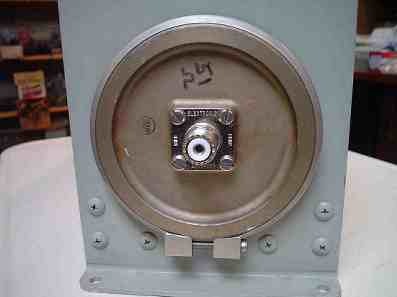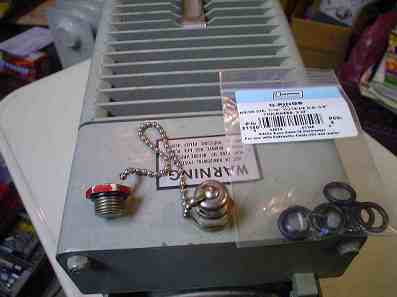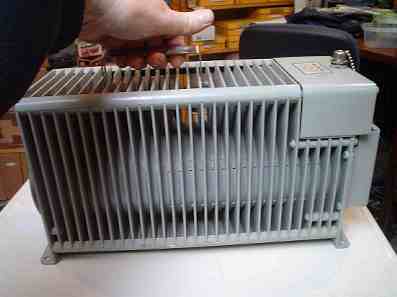|
Who says you can't get good deals on Ebay.........
My Honey, Don KC2VLI surprised me with this nice Bird Dummy Load (about
$45) for my test bench.
If you are testing big amplifiers or full legal limit AM rigs, you need a professional grade dummy load. The cheaper dry dummy loads have a duty cycle that limits time of operation. The paint cans can spill, and should be placed in a metal pan to catch any spills of the oil if it boils over. Remember these get hot, and a plastic sink pan for washing dishes can melt. With these Bird dummy loads, all those problems are eliminated. If you work on big amps for EME or satellite work, a dummy load must deliver performance at VHF and UHF frequencies, and the cheaper alternatives will not cut it. A used Bird dummy load is cheaper than any of the new dummy loads on the market, and works better. Here are some tips to evaluate any dummy load you find at the ham fest.
For TERMALINE COAXIAL LOAD RESISTOR MODELS 8251, 8252 & 8255: The Spec Sheet is available at:
http://www.bird-technologies.com/en/Resources/DiscontinuedProducts/~/media/Bird/Files/PDF/discontinued-manuals/920-8251_8252_8255_coaxial-load-resistor.ashx.



When you first put a dummy load in service, carefully measure the DC resistance and record it for future reference. If it changes, look for the cause and you may be able to correct it, or at least assess the damage.
Used Bird dummy loads are available for around $50 - $75. They are bulky and heavy, so these live under your desk. They do have a handle, but they are portable only in the military sense. Not the sort of thing you put in a briefcase sized tool kit. If you look at the big Bird dummy loads at the swap meets, check the resistance first. Then unscrew the cap to the filler for the fluid and make sure it is not empty, and there is no evidence of corrosion. You will need to carry a small flashlight in your ham fest tool kit to see this. There is some room left for expansion as you heat it up, so do not add fluid unless it really needs it. This is fancy unobtainium NON PCB transformer oil, and you can get it, but you have to know somebody. The manual states: "The unit is factory filled to the proper level with 0.8 gallons (3.03 liter) of Bird P/N 5-1070. No other coolant should be used." Also there should be an O ring installed. "Do not leave out the O-Ring seal, P/N 5-504 when interchanging the vent and shipping plugs." The last thing to check on a Bird is the connector, often a type N. Be aware there is a slightly larger N connector used in the broadcast industry that will not fit a standard N coax cable or adapter. Carry a standard N connector in your test gear bag or pocket to check the size before you buy. The standard N to SO-239 adapters are cheap and widely available. I was lucky enough to have in my junk box the correct SO-239 connector and plate for the Bird I bought. The boss at the 2 way radio shop I worked at had me convert the Bird Wattmeter to N connectors, so the SO-239s were discarded. I never throw anything away; it was just a matter of digging through bins in the garage.
Do not store or operate these dummy loads in any other position than the one shown in the photos. Warning: at full power, these get very hot when run for extended periods. Allow plenty of air circulation and do not sit them on anything that can be damaged by heat. Observe standard safety precautions when working on live equipment, as well as RF radiation exposure rules.
See this page for instructions on measuring RF power output:
http://www.dudleylab.com/Appnote-4-Power-tests1.pdf
I hope you found this web page helpful for shopping for equipment or repairing something that got damaged. I also try to explain "why" something works the way it does, so that you can become more proficient in the technical aspects of amateur radio. I recently had a discussion with a new ham about the Bird dummy loads; he thought that they were only good for UHF and would not work on HF. If you can measure the resistance with a meter, it is good to DC. Likewise, the MFJ 260 spec is misleading, since they state the frequency span as 1 MHz to something. These dummy loads will work just fine below 1 MHz for your 2200 and 600 meter band testing. They are OK for audio too, but not much audio gear is 50 ohm. You can load test a 13 VDC power supply, but it will only draw about 0.26 amps. It really helps to understand the theory, not just memorize the answers to test questions. Invest some time experimenting to add to your enjoyment of ham radio. Its worth the effort!
|